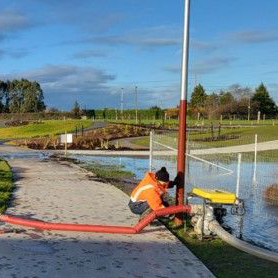The International Erosion Control Association (IECA) presents the webinar – Let’s Talk Floc: New Zealand aPAM Flocculant Solutions for Water Treatment and Erosion & Sediment Control – on December 10, 2024, at 3 p.m. MT in the U.S. and on December 11 at 9 a.m. AEDT and 11 a.m. NZDT for Australia/New Zealand. The webinar is hosted by the IECA Australasia Chapter and you can register here.

Expert presenters, Seva Iwinski Bray (President, Applied Polymer Systems) and Blair Gray (Principal Environmental Consultant/Director, EnviroCo Ltd), will share insights into how aPAM flocculant technologies are revolutionizing erosion control and water treatment in New Zealand.
Flocculants are powerful tools that have been used globally for decades to preserve and restore our water resources. Commonly used in mining and mineral processing, municipal and wastewater treatment, and agriculture, flocculants have also become a staple for construction and stormwater treatment.
Today, flocculant treatments are regularly used for erosion control, soil stabilization and the removal of harmful stormwater contaminants such as sediment, nutrients, and metals. Although there are many types of flocculant and coagulant treatments available, anionic polyacrylamide (aPAM) is the most widely used and accepted due to its safety to aquatic organisms, efficacy in reducing turbidity, and versatility in treatment applications.
aPAM technologies have the ability to achieve low TSS/NTU levels that conventional best management practices cannot. Over 70 years of research and use of aPAM technologies has shown turbidity reduction up to 95 percent. Due to the numerous benefits of aPAM usage, New Zealand has recently adopted aPAM technologies as an approved practice to protect soil and water during and after earth moving activities.
This webinar will discuss the history, use and benefits of aPAM technologies, regulations, and examples of aPAM technologies recently used in New Zealand. It will discuss current projects and uses that have been completed or are ongoing within the region and future usage.
Learning outcomes:
1. Recognize what aPAM is and how it can be used to treat water, stabilize soil and enhance BMPs
2. Understand the safety and efficacy of aPAM flocculants as well as other chemical treatments
3. Identify the current role and implementation of aPAM technologies in New Zealand and how they may be used in the future to protect and restore New Zealand’s natural resources
 TEXTILES.ORG
TEXTILES.ORG


